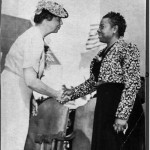Cheryl A. Head's Blog, page 15
January 17, 2016
The Day the King Died
The Day the King Died
(Detroit, 1968)
She saw it on television, the King was dead and mama was crying. She said he was a real good man and then held onto me so tight I could hardly breathe. Every time mama answered the phone she cried again. Daddy hugged mama a long time.
I didn’t have to go to school so I watched TV.  Wile E. Coyote was trying to catch the Road Runner but he kept falling off a cliff or getting smashed as flat as paper. When daddy changed the channel, we saw buildings on fire and lots of smoke and people running around just like in the cartoons. Daddy told me everybody was mad.
Wile E. Coyote was trying to catch the Road Runner but he kept falling off a cliff or getting smashed as flat as paper. When daddy changed the channel, we saw buildings on fire and lots of smoke and people running around just like in the cartoons. Daddy told me everybody was mad.
“Are you mad, daddy?”
“Yes, I’m angry son. I’m sad, too, because Dr. King was trying to help our people and now he’s gone.”
Daddy took a handkerchief from his back pocket and blew his nose. Then we heard a big rumble and the house kinda shook. Daddy ran to the window and I followed. An army tank was rolling down the street in front of our house. It was green and had a long gun on the front and funny wheels. It sort of reminded me of the giant tortoise at the Detroit Zoo.
Uncle Butch came to our house. He had a refrigerator and a bunch of meat. Daddy wanted mama to cook some ham for Uncle Butch, but she wouldn’t do it.
“Sam, you know that stuff is looted. I’m not going to cook it or eat it. It doesn’t belong to us.”
Mama sat at the kitchen table and folded her arms. The vein on daddy’s neck jumped like it did when he was paying bills. He got mama’s biggest pot and put water in it.
“Woman, we are not going to throw away good food,” he yelled. “I’ll cook the damn meat myself. Money don’t grow on trees.”
Daddy said that a lot. About trees. He was right. Me and Kenny shot marbles under that big oak in his yard every Saturday for the whole summer and we didn’t see even one penny.
For dinner, mama made spaghetti but daddy said he was going to have a ham sandwich. He offered me a piece and I took it.
“How is it, Casey?” mama asked.
It tasted like a rubber band. One time Kenny and me ate a rubber band. I had tears in my eyes.
“What’s wrong, Casey, is it too salty?” mama asked. She was giving daddy the evil eye.
Daddy was chewing and swallowed hard to make his sandwich go down. He gave me a drink of his water.
“You are a stubborn man. To stubborn to eat crow.”
Daddy just kept on chewing. I never tasted crow, but I think it might be better than looted ham.
Mama, daddy and me watched TV and mama cried some more. “They shot Dr. King,” she said after we said our prayers, “but they can never kill him.
When I fell asleep I was thinking about Dr. King and the Road Runner.
January 16, 2016
Eva Jessye: Women of the March on Washington-In Tribute to Dr. Martin Luther King, Jr.
She “was the first black woman to receive international distinction as a professional choral conductor” reads the Wikipedia entry for Eva Jessye. But I hadn’t even heard of her and wondered why she and her chorale had been invited personally by Martin Luther King, Jr. to be part of the official program for the 1963 March on Washington for Jobs and Freedom.
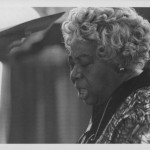
Jessye began her musical career as a teenager organizing choral groups in her hometown in Kansas where she attended college at age thirteen. In 1919, she was the choir director for Morgan State College in Baltimore. She formed the 16-member Eva Jessye Choir in 1926 performing regularly on WOR radio in New York and touring the country. In 1929, she was the choral director for the MGM film Hallelujah directed by King Vidor; in 1933, Jessye worked with composer Virgil Thomson and author Gertrude Stein on the opera Four Saints in Three Acts which opened with an all black cast on Broadway a year later. In 1935, Jessye began a two-decade collaboration with composer George Gershwin as his choral director for Porgy & Bess. She also appeared in several movies.
Ms. Jessye’s travels throughout the U.S. gave her first-hand experience with Jim Crow laws and she joined many of her contemporaries-including Mary McLeod Bethune, Langston Hughes and Paul Robeson-as an active supporter of the civil rights movement. Perhaps King admired her for her profound talents as a composer, actress, poet and teacher, as well as her intellect.
Ms. Jessye-a creative force in American music for well over a half century-died in 1992 at the age of 97. A large collection of her personal papers including music, writing, correspondence, photos, newspaper clippings and legal documents are housed at Pittsburg State University in the Leonard H. Axe Library in Pittsburg, Kansas. A similar repository of Jessye’s works and papers are at the Bentley Historical Library at the University of Michigan where, in 1974, she established the Eva Jessye African-American Music Collection.
At the historic March on Washington, the Eva Jessye choir performed one of her own compositions, “Freedom is a Thing We’re Talking About.”
Photo Credits:
~Eva Jessye. I Dream a World, 1989 copyright Brian Lanker.
~Eva Jessye with Eleanor Roosevelt circa 1940. Kansas Historical Society
Resources:
Wintz, Cary D., Finkleman, Paul. Encyclopedia of the Harlem Renaissance Volume 1 A-J. Eva Jessye (p. 617-618)
Conlon, Joan C. Editor. Wisdom, Wit and Will: Women Choral Conductors and Their Art. Eva Jessye chapter by Joan Whittemore (p 419-434).
Eva Jessye Collection. Pittsburg State University
http://library.pittstate.edu/spcoll/ndxjessye.html
website: Another Ann Arbor http://anotherannarbor.org/home/2013/02/17/if-i-belong-to-anything-i-belong-to-my-music-eva-jessye-1895-1992/
website: WGBH Open Vault Say Brother (1 minute video) http://openvault.wgbh.org/catalog/sbro-mla001072-eva-jessye-black-american-folk-music
June 22, 2015
The Confederate Flag is a Red Herring
The outrage about the flying of the confederate flag over the South Carolina statehouse has been refueled and re-furled after the horrific shooting and hate crime committed at the Emanuel African Methodist Episcopal Church in Charleston.

I don’t care whether they take this flag down or not. Because this symbol is not the reason for America’s racial issues. America’s soul is the issue. Whether we know or acknowledge it our nation is suffering from a wounded soul. One that will never heal until we face, head on, our history with racial injustice.
It is difficult to have conversations that uncover discomfort, shame and guilt. But putting a salve on our collective souls cannot begin until we engage in this sustained dialogue. It will make us hurt. It will test our hearts. It will make some of us hunker down in our prejudices and fear. Transformation is difficult and attitude change is a daunting task. For 150 years we’ve changed laws, changed policies and enforced new behaviors. I’m grateful for the changes. But only confronting the core of our beliefs, self-reflection and an openness to understand how we benefit from change can truly set us free from bigotry and its residuals.
In the short term, taking down walls, fences, signs, and flags can make us feel good. But the work of racial healing cannot be successful through surface acts. In the long run we must go past the color of skin and flags. Go deeper to view our soul’s hue.
I mourn the loss of nine souls. And the irreparable damage to the lives of their loves ones.
June 9, 2015
I’m Signed!
 Very, very pleased and proud to be joining the roster of fine writers at Bywater Books. I can’t wait to begin the adventure.
Very, very pleased and proud to be joining the roster of fine writers at Bywater Books. I can’t wait to begin the adventure.
http://www.bywaterbooks.com/bywater-b...
June 5, 2015
Black soldiers on D-Day: “We Were There.”
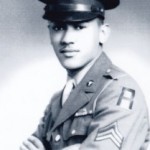 Waverly B. Woodson, Jr was a medic on D-Day. Despite his own injuries from a mine explosion, Woodson continued to treat other wounded soldiers for 30 hours. His actions, chronicled by his white superior officer, earned him a Bronze Star. But Woodson is only one of many black soldiers who acted out of duty and honor to their uniform.
Waverly B. Woodson, Jr was a medic on D-Day. Despite his own injuries from a mine explosion, Woodson continued to treat other wounded soldiers for 30 hours. His actions, chronicled by his white superior officer, earned him a Bronze Star. But Woodson is only one of many black soldiers who acted out of duty and honor to their uniform.
On D-Day, June 6, 1944, Allied forces executed a massive invasion along a 50-mile stretch of coastline in northern France occupied by Hitler’s so-called Fortress Europe. D-Day was a massive operation, the largest amphibious force in American military history, and involved 5,000 ships and landing craft, 160,000 troops and 11,000 aircraft providing support.  Four thousand Allied troops died in the Normandy invasion and thousands more were wounded or missing as troops scrambled ashore drawing machine-gun fire from the cliffs above the beach. Omaha and Utah beaches were assigned to U.S. Forces. The U.S. First Army Division faced heavy opposition on Omaha Beach where
Four thousand Allied troops died in the Normandy invasion and thousands more were wounded or missing as troops scrambled ashore drawing machine-gun fire from the cliffs above the beach. Omaha and Utah beaches were assigned to U.S. Forces. The U.S. First Army Division faced heavy opposition on Omaha Beach where 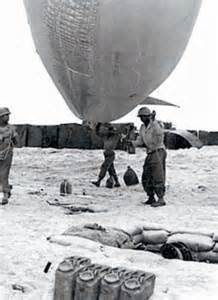 2,000 American soldiers died. On that morning, seventy-one years ago, Negro soldiers did their part with tenacity, adaptability and bold action. Some 1,700 black troops were part of the First Army including the 327th Quartermaster Service Company and the 320th Anti-Aircraft Barrage Balloon Battalion, which used helium-filled balloons tethered to explosives to thwart German aerial attacks.
2,000 American soldiers died. On that morning, seventy-one years ago, Negro soldiers did their part with tenacity, adaptability and bold action. Some 1,700 black troops were part of the First Army including the 327th Quartermaster Service Company and the 320th Anti-Aircraft Barrage Balloon Battalion, which used helium-filled balloons tethered to explosives to thwart German aerial attacks.
A Distant Shore: African Americans of D-Day is a 2007 History Channel documentary which brings to life, through first-person testimonials, the challenges of black troops on D-Day. “You see movies and stuff. The Longest Day, you don’t see know African Americans. Private Ryan, no African Americans….but we were there!”
On this day of commemoration of D-Day. I salute these unsung heroes.
June 3, 2015
Buffalo Soldiers Still Remembered
Great to meet and be interviewed by the fabulous Maggie Linton this week at the SiriusXM studios -The Maggie Linton Show. We discussed my book: Long Way Home: A World War II Novel.
Maggie’s father served in both WWII and the Korean War and was a member of one of the African American military units (Buffalo Soldiers) at Fort Leavenworth.
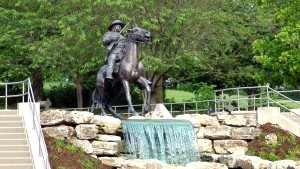
The Buffalo Soldier Monument was an idea that originated with retired Gen. Colin Powell when he was assigned to Fort Leavenworth in the early 1980s as a brigadier general. He believed something should be done to recognize the contributions and achievements of the Buffalo Soldier units.
See more at: http://www.kansascity.com/news/local/article1607698.html

